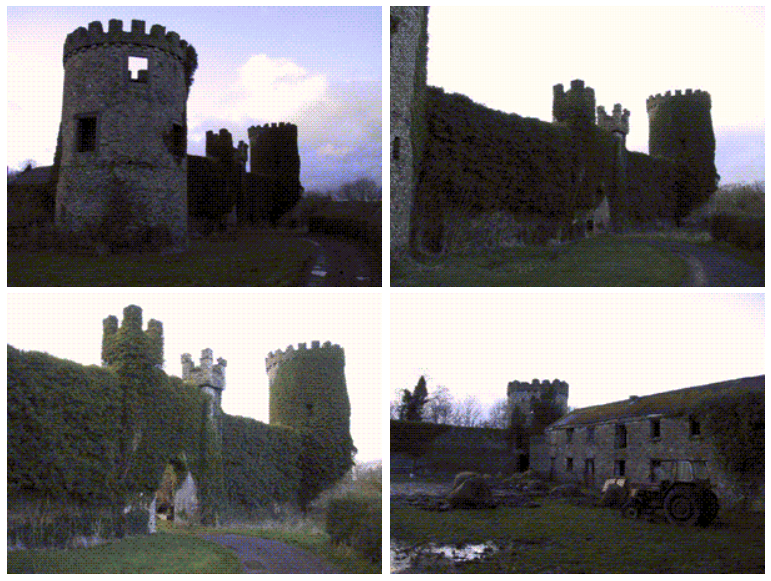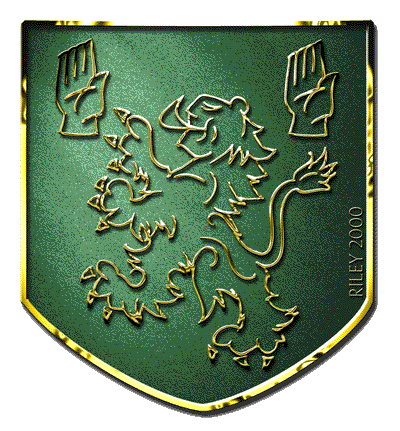Surname | Coat of Arms | Kings | Castles | Gathering | Articles | Notables
Dromagh Castle
Drom Ath: The Ridged Country

The remains of Dromagh Castle of the O’Keeffes are impressive. Four round towers about 50 feet high guard a square court facing east, at which side there is an entry arch. The south-east and north-east towers are perfect externally – except that the roofs are gone. The flooring is gone in each case. There are indications of an attached building with a ‘V’ shaped roof at the north-east tower. The battlements of the tower to the south-west are gone and the north-west tower is covered in ivy. There was formerly a five story tower house, as the mian building, in the centre of the yard, but there is no trace of this now. The yard is about 50 yards by 35.
The ruin lies up a driveway to the right of the road from Banteer to Boherbue. There are two entries – just before and just after a church at the side of the road not quite half way between the two towns mentioned. The O’Keeffes had castles also at Duarigle and Drominagh, and fortified homes at Ahane, Ballymaquirk and Cullen, although some doubts are expressed about the latter location: they may have had a fortification over Nohaval Bridge. These are all commented on separately.
The O’Keeffes were an Irish family of the Eoghanachta and held extensive land around the plains of Fermoy from where they were driven westward by the advance of the Norman Roches, Condons and FitzGeralds. They then became established around the area of Dromagh, which was their principal fortress. They traced their name from Caoimh, Son of Fionguine, who was killed in battle in 908 A.D. His name is also associated in semi-myth form an earlier period in which he was said to have been assisted by the Druid Mogh Ruith in war, and afterwards married the Druid’s daughter Cliona, head of the Munster Fairies. In truth the family history of the O’Keeffes, even in the seventeenth century, is somewhat confused, and disagrees about who was what, and when. It does emerge that Art O Caoimh, who owned Duarigle, got a regrant of his lands in 1582. Dromagh appears to have been built around this time. They did not support the Desmond rebellion, and it is recorded that Aodh O Caoimh died in pursuit of the Earl. Shortly after the chieftain Art (son of Donal, son of Art) was killed and Art Oge (d. 1610) succeeded his father. Donal, son of Manus (d. 1636) succeeded him. This Donal of Ballymaquirk was very active in the Confederate War; backing Ormond against the disastrous policies of Rinnucini, the Papal Legate. His brother Hugh, nicknamed ‘Paschalis’, appears to have been the chief at that time and also had an adventurous life. It is said of him that when captured by the Cromwellians and having given his word not to escape, he stood up one morning and saying ‘Gentlemen, I give you notice – “I’m off”‘, jumped out of a window to freedom, considering that the ‘notice’ cancelled any previous undertakings! He was governor of Dromagh in 1652 at its capture by Cromwell, when he was allowed to march out fully armed to join the dying cause of Muskerry.
The property was attainted but restored to Donal’s son, also Donal, by Charles II, who was aware of the support given to him on the continent by the O’Keeffes. The family history is a little contradictory at this point, but there were a succession of ‘Daniels’ and ‘Donals’ and events become a little confused. It would seem that the third Daniel was killed fighting at Aughrim for James II, and his son, another Daniel, was taken to France as an infant. A family member ‘Donal a Rasca’ lived as a rapparee in a cave until he was betrayed by his female companion Maighread Ni Ceallaigh. When learning of the betrayal he stabbed her, and their story has becomed part of local lore. At any rate following the Jacobite period the lands were finally lost to the family.
Lord Muskerry marched out of Dromagh Castle to encounter Broghill at the fateful battle of Knocknaclasy, where the last spark of hope for the Confederate Irish was quenched in 1651. Both sides sought to get to the siege of Limerick each hoping to swing the battle there to advantage. Limerick capitulated soon after, and although Muskerry was not to surrender until the following year at Ross Castle, Killarney, the fight was to all intents and purposes over. The battle was fought mainly to the south of the Blackwater, near Ballymaquirk.
The family of Leader eventually got the property and operated a series of collieries nearby.
A legend suggests that part of the O’Keeffe family fortune was thrown into the well in the yard to save it from Cromwell’s soldiery. This is an often repeated story of those times, and it is perhaps sufficient to say that it has never been found. The land is farmed by the O’Leary family. (1)

(1) The Castles of County Cork With 72 line drawings and 10 maps
by James N. Healy
Copyright © 1988 by James N. Healy, p. 331-332.
Material reproduced by permission of the publisher.
The Mercier Press Limited
4 Bridge Street Cork
24 Lower Abbey Street, Dublin 1

